Ozoni (Mochi Soup), Osechi-Ryori (Japanese New Year Food) and Oshogatsu 2011 (New Year)
Goodbye 2010, hello 2011!
Akemashite omedetou gozaimasu! Happy New Year!
The holiday season flew by so quickly, I almost can’t believe the New Year has arrived. Yet here I am once again, asking Bebe Dada if he made any New Year’s resolutions. He told me he did, but this year he is keeping them to himself. While I wouldn’t share them on my blog even if he did tell me what they were, the nosey side of me nagged him for a good 10 to 15 minutes, repeatedly asking, “What are they? Come on, tell me, please? Why won’t you share!” I’m annoying, I know.
I myself think about making resolutions at the beginning of each year, but ultimately I stray from making any specific resolutions such as eating healthy or exercising, for example. I admit that I don’t really make any resolutions, not because I don’t believe I will keep them, but because throughout the year I often find myself reflecting upon my day, or specific situations and I think about how I could have handled something better or how I could be a better person, mother (step), wife, daughter (in-law), sister (in-law), aunt, niece or friend. (Sounds like that “continuous improvement” concept my business books kept referring to back in the day when I actually read business books.) The bottom line is that despite my short-comings, mistakes, missteps, misspoken words or actions, deep down inside, I always want to do better and be an even better person although sometimes it might not always seem that way.
Mom’s Kagami Mochi New Year’s decoration flanked with 2011 Year of the Rabbit Ceramics. The two different sized mochi’s were handmade by my BFF’s parents who do mochitsuki (make mochi from scratch) every year. According to Wikipedia, the two mochi symbolize the coming and going years. The daidai (or bitter orange atop the mochi, which is actually a Satsuma Mikan in the photo) is said to represent the continuation of a family from one generation to the next. In addition, the kagami mochi display sits atop a sheet of paper, or shihobeni, which is believed to ward off fires from the home. Every year, for as long as I can remember my Mom displays kagami mochi around New Year’s. It’s a tradition I’ve always associated with oshogatsu.
On a lighter note, a lot has happened since reflecting about New Year’s resolutions and my last post in mid-December 2010. We celebrated Christmas with my husband’s side of the family, then with my side of the family, and then with my sister-in-law’s side of the family. I also had the chance to reconnect with some friends from high school that I hadn’t seen in a very long time, as well as to enjoy a leisurely lunch with a handful of my best friends.
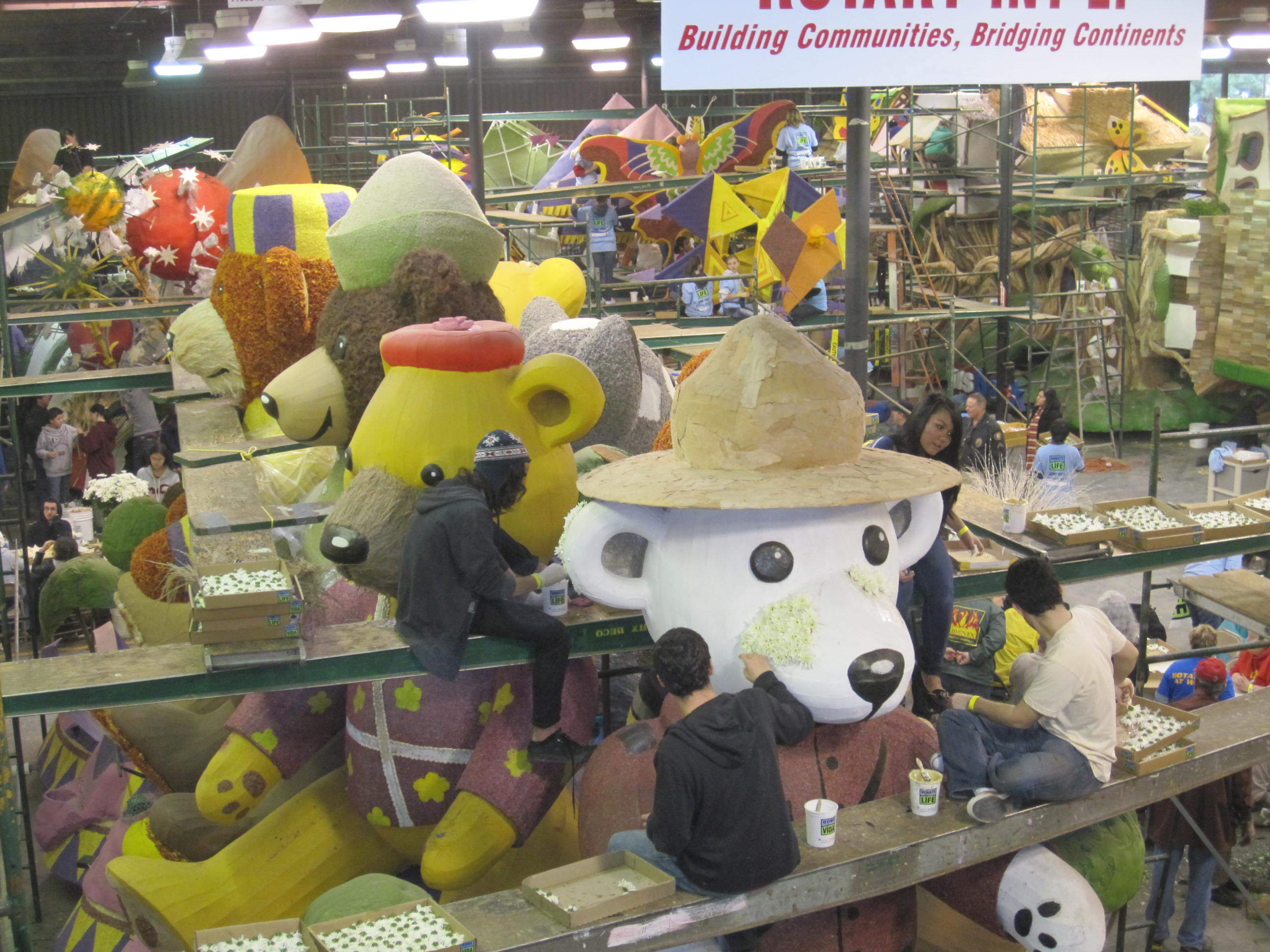 2011 Rose Parade Float – Pasadena, California.
2011 Rose Parade Float – Pasadena, California.
We thought the Rotary Club’s bear float was really adorable. We watched the volunteers glue white mums to the bear’s face.
Last week, one of the fun day-trips we took was to Pasadena so that we could watch the Rose Parade floats being decorated. I hadn’t seen the floats decorated in years and it brought back good memories of my childhood. An Uncle was a long-time supporter of the Tournament of Roses and annually served on it’s committee. He often took my Aunt and I to watch the floats being decorated but I have even fonder memories of walking to the parade from my grandparent’s home in South Pasadena with my family to watch the floats, bands and horses turn the corner on Orange Grove. After the parade we always went to look at the floats on display so we could experience the beauty of them close-up and enjoy the wonderful smell of the flowers.
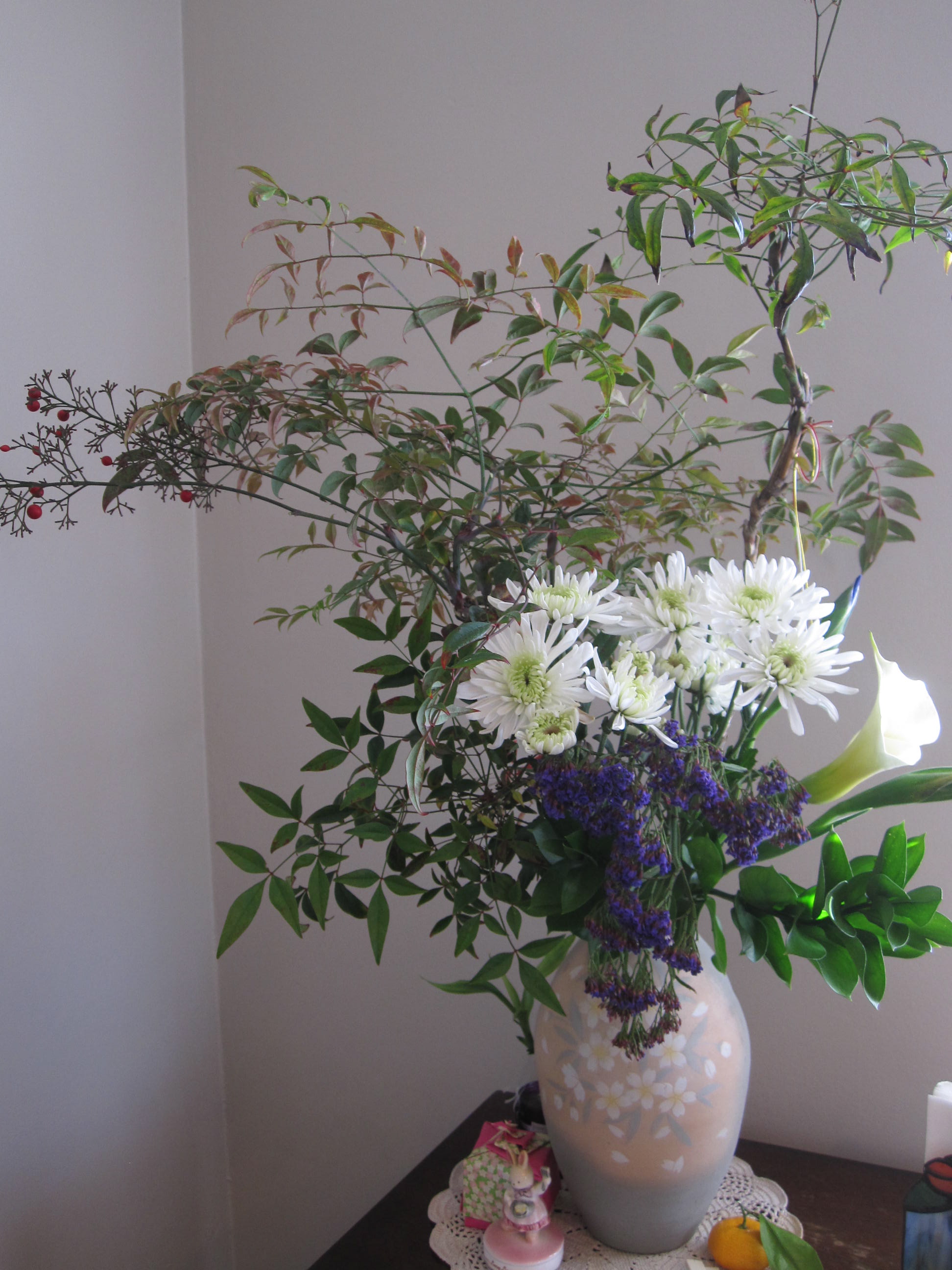 Mom’s Oshogatsu Ikebana Display.
Mom’s Oshogatsu Ikebana Display.
My Mom is a master ikebana sensei (flower arrangement instructor) although she has since retired from teaching.
While this childhood Rose Parade tradition eventually changed when my grandparents left California and moved to Japan, one family tradition that hasn’t changed is that we always celebrate oshogatsu with family, and we always eat ozoni on New Year’s morning. Actually, in my youth I often ate ozoni for lunch since I couldn’t wake up in the morning after an evening celebrating New Year’s Eve. Other times, my parents had to postpone our oshogatsu celebration until the early afternoon so that I had time to drive back from Las Vegas. Ah, the days of my youth… seems so long ago but it was only four years ago that Bebe Dada and I last celebrated New Year’s Eve together with friends in Vegas! It’s crazy how fast time flies. Anyway, regardless of the time of day, ozoni is still the first soup with which I always start the New Year. In addition to eating ozoni, we celebrate the New Year by feasting on osechi-ryori, traditional Japanese New Year’s food.
As a child, I never really cared for osechi-ryori, with the exception of kazunoko (herring roe) and koya dofu, but every year I ate a number of foods that I eventually grew to appreciate. Today, we eat traditional foods as well as a host of Japanese delicacies such as sushi and sashimi. My mom always encouraged my brother and I to take at least one bite of each traditional osechi-ryori because each food had meaning and if eaten, would bring good things to us in the New Year. I almost forgot about this tradition, given I’ve only been eating the foods that I like for many years now, yet, remembering this compelled me to Google osechi-ryori to research the meaning of each food in detail.
I should also mention, that back when we were children, my Mom made each and every one of these foods. That’s over 10 different types of osechi ryori. As a child, I never truly appreciated all the hard work my mom spent in the kitchen preparing our food for oshogatsu, but I certainly do now. Thank you, Mom, for allowing us to experience these traditional, home-cooked Japanese foods when we were growing up! I feel very fortunate for these memories and for learning about our Japanese culture and heritage. I know I complained A LOT about having to take ONE bite of foods that I didn’t like, but I am thankful nonetheless.
Japanese Hagoita – New Year’s Paddle with Princess.
My maternal grandparents sent this to me from Japan for my first oshogatsu I celebrated as a baby. It is traditional to gift these paddles to young girls on New Years Day.
(Yikes, this makes this a bit of an antique considering my age.)
The following are some of the dishes from our osechi-ryori and other Japanese dishes we enjoyed on oshogatsu 2011.
First, I’d like to begin by sharing the plate that I made for myself. I knew I should have grabbed one of the bigger plates!!! Mom, please let’s just use the bigger plates from now on. Let’s forget the smaller plates!
One of my best friends, M, (yes, one of the 9 girls I grew up with) joined us for oshogatsu this year, and she mentioned visiting her Auntie in Japan during oshogatsu who told her that they would eat osechi-ryori for three days, breakfast, lunch and dinner. She was appalled by this. I wondered about this tradition and in my research I learned that it is taboo to use the hearth (or kitchen) on oshogatsu, with the exception of cooking ozoni. All osechi-ryori is prepared and cooked by the end of the year so that no cooking takes place during the first three days of the New Year. I never knew why we had to eat the same osechi-ryori leftovers for two days after New Year’s Day and my Mom didn’t cook anything during this time! I always believed she was just tired from all the preparations.
- Kazunoko (herring roe) – I love kazunoko. This is my favorite osechi-ryori dish because we truly only eat this once a year on oshogatsu. It is teeny-tiny roe that is crunchy and flavorful. I must have been a weird child because I’ve loved kazunoko for as long as I can remember. (I will have a separate post for this recipe in the future.) “Kazu” in kazunoko means number, and “ko” means child. Kazunoko symbolizes a wish for many children in the New Year. (I’m sure my parents didn’t hope for numerous grandchildren in the New Year when I was eating tons of this in my childhood, but I’m certain it was a wish they hoped would come true in the future.) Kazunoko recipe is available here.
- Kamaboko (fish cake) – Every year my Mom buys fancy red (which actually looks pink) and white kamaboko especially for oshogatsu. It turns out, that the red and white kamaboko arranged in a row is reminiscent of Japan’s rising sun and has both celebratory and festive meanings.
- Konbu (seaweed) – Every year my Mom prepares konbu tied in a pretty knot or konbu that is stuffed with cooked salmon. (Actually, I think last year the mom of one of my best friends gave us some of the stuffed konbu she made but this year we unluckily did not receive any.) I really enjoy konbu stuffed salmon (Mom – hint, hint) but this year my Mom prepared a simpler konbu tied in a pretty knot. It was delicious nonetheless. (This is another recipe I hope to post in the future.) Konbu, is a word in Japanese associated with yorokobu which means “joy”.
- Kuro-mame (black soy beans) – Kuro-mame was never a favorite of mine, and I still avoid this every year with the exception of one or two beans but I dutifully fed a few to Bebe E, who unfortunately spit them out. They are slightly sweet and salty in flavor. For some reason I thought the kuro-mame looked smaller in size this year. Anyway, in Japanese, mame, in addition to meaning “bean”, also means “health”. Kuro-mame sybolizes a wish for good health in the New Year. I firmly believe that if Bebe E had eaten her kuro-mame rather than spitting them out, she would not have endured a fever all night on Monday and Tuesday. She’s doing better but the poor thing is still not feeling well. Mama and Dada are still recovering from this ordeal. It’s not fun when little babies are ill. Please, everyone eat their kuro-mame! Kuromame recipe is available here.
- Shiba Ebi (shrimp) – Every year for as long as I remember we always have an abundance of shiba ebi at oshogatsu. These small shrimp are usually sold pre-cooked and frozen. They are slightly salty and while they only have a little meat, it is succulent and each shrimp has an abundance of roe which is quite delicious. The roe is my favorite part of the shrimp. Because these shrimp are so small, I can easily eat a handful. The only challenge is de-shelling and getting to the meat and roe. While Wikipedia did not mention any meaning behind ebi, I imagine the roe of the shiba ebi signifies the hope for fertility. In addition to shiba ebi, this year we also had cocktail shrimp and prawns cooked in soy sauce and sake.
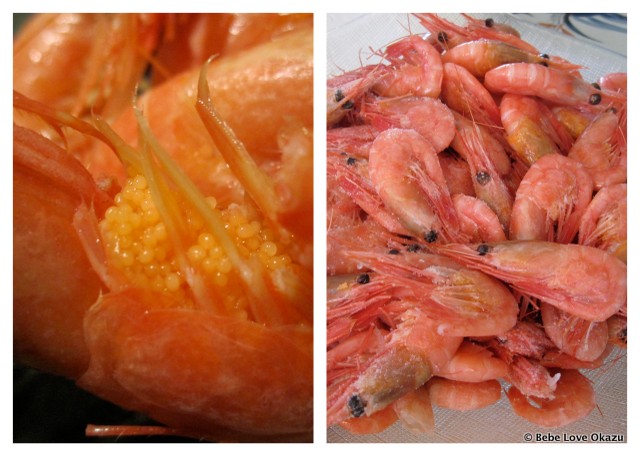 The photo on the right is a close-up of the shiba ebi roe.
The photo on the right is a close-up of the shiba ebi roe.
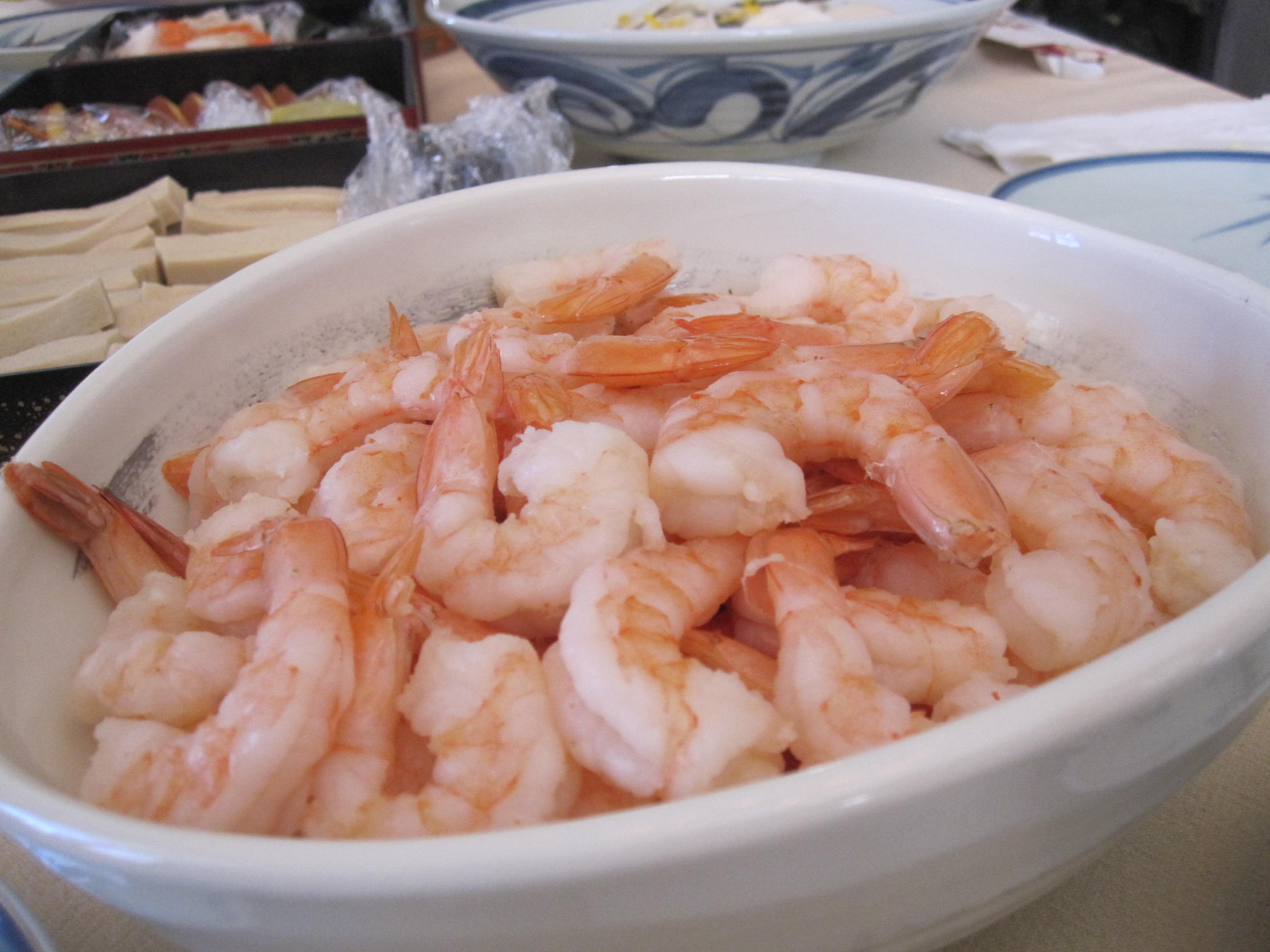 Mountain of Succulent Cocktail Shrimp.
Mountain of Succulent Cocktail Shrimp.
- Tamagoyaki or Nishiki Tamago (egg roulade) – In our family, we usually make tamagoyaki (Japanese egg omelette) rather than make nishiki tamago, which is an egg roulade where the yolk and egg whites are cooked separately. The yolk or yellow symbolizes gold and white symbolizes silver, both celebratory colors. Sometimes, my Mom will buy nishiki tamago but usually my Dad will make tamagoyaki. This year, however, he was feeling a little tired and wasn’t up to making tamagoyaki for us. (Next year, I will volunteer to make hourensou tamagoyaki.) Fortunately, there were a few pieces of tamagoyaki in the oseschi-ryori platter my Mom ordered from Yuzen (a Japanese restaurant in WLA). It is the yellow rectangles on the platter below.
- Daikon No Sunomono (vinegared radish salad) or Namasu– This year, both my Auntie Sumiko and my Mom made daikon no sunomono. My Auntie made hers with daikon (radish), lemon and konbu (seaweed), and my Mom made hers with daikon and carrots and garnished this with toasted sesame seeds. There are many variations of sunomono salad and my Mom’s oshogatsu sunomono differs slightly from the daikon and ninjin sunomono I posted previously, so I might post her oshogatsu version (as well as my Auntie’s) at some point.
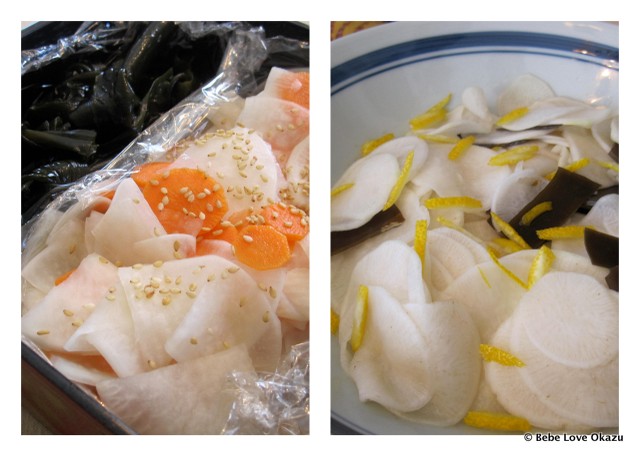 The sunomono on the left is my Mom’s and the sunomono on the right is my Auntie’s. Both were delicious!
The sunomono on the left is my Mom’s and the sunomono on the right is my Auntie’s. Both were delicious!
- Datemaki (sweet rolled omelette mixed with fish or shrimp paste) – My Mom usually doesn’t make this, and instead buys this in a roll, similar to how kamaboko is sold. It is sliced then served. In the jubako (special Japanese box which resembles a bento box) photographed under the kamaboko secion above, you will see on the left-hand of the box a dark brown and golden slices of datemaki. Unfortunately, I did not have the chance to try a slice this year, nor photograph it! Datemaki symbolizes a wish for many auspicious days in the New Year.
- Tazukuri (dried sardines) – This is a traditional osechi-ryori dish that my Mom serves every year, but this year she forgot about it. LOL. Last year, she forgot to make koya-dofu which I was very upset about and this year she forgot tazukuri. This is a simple dish of dried sardines cooked in soy sauce and slightly seasoned with sugar and garnished with sesame seeds. I usually only eat one or two of the very tiny fish and honestly did not even notice it was missing until I came across it in my osechi-ryori Google research. I called my Mom to tell her that we forgot tazukuri and she asked me in Japanese to add it to our oshogatsu list for next year so that we don’t forget. She said she would make some for us the next time we had a chance and I already have a bag of dried sardines at home so the post is forthcoming!
- Renkon No Nimono (simmered lotus root with mixed vegetables) – Every year we have nimono at oshogatsu. This year my Auntie Sumiko filled two jubako’s with renkon no nimono. In one of the jubako, the nimono was flanked by sea snails. Renkon is a traditional Japanese vegetable I grew-up with and a familiar friend at oshogatsu. My Auntie’s renkon no nimono included carrots, green snow peas, satoimo, shiitake mushrooms, gobo, konnyaku, and chicken.
- Tai (red sea breem) – In Japan, tai is often associated with celebratory events and tai is associated with the Japanese word “medetai” which symbolizes an auspicious event. This year, I believe we had grilled tai on our platter that was ordered from Yuzen. (Photo seen above under the tamagoyaki section.)
Sashimi, Sushi, and other Seafood – While sashimi and sushi are not typical of osechi-ryori, it’s been our family tradition to have a variety of sashimi, nigiri sushi, inari sushi, and maki sushi on oshogatsu.
Big prawn, little prawn.
Hideki, my brother-in-law, is a photographer and he took photos of some of our food, including this one. I’ve featured a few of his other photos throughout this post. Please take a moment to visit his site to view his portfolio.
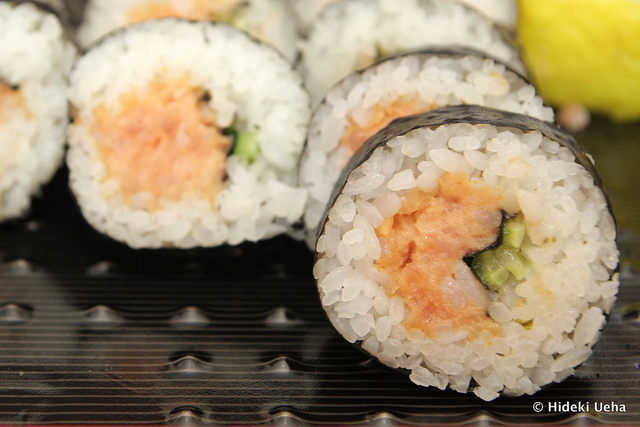 Photo credit: Hidek Ueha.
Photo credit: Hidek Ueha.
A first for us this year were escargot – snails of the sea. My Auntie Sumiko packed them in the jubako with the renkon no nimono. Only a few of us were brave enough to try them. My Jichan (paternal grandpa) used to eat these all the time and whenever I visited him in Japan there were always an abundance of them at the dinner table. Granted, these were not nearly as large as the ones we feasted on oshogatsu, but eating these were nostalgic and brought back fond memories of my Jichan.
This was Hideki’s escargot that he pulled out of it’s shell (he didn’t do a good job getting it out in one piece), only to photograph it…. I ate it, because he wouldn’t.
This was my escargot. Yes, I ate TWO of these suckers!
There was something about these that were a little gross, yet, I enjoyed them and they were delicious!
- Kuri Kinton (mashed chestnuts and sweet potatoes) – This is another oshogatsu dish I’ve never been a fan of but every year I dutifully try one bite. I believe this year, a friend of my Mom’s made a huge batch of kuri kinton and shared a small portion with us. As you can see, we just left it in the Ziplock baggie in which it was delivered to us and placed it in the jubako. Oh, I almost forgot to mention that the golden-yellow color of the kuri kinton symbolizes the wish for prosperity in the New Year.
Kuri Kinton
- Daidai (Japanese bitter orange) – In Japanese, daidai means “from generation to generation” and it symbolizes a wish for fertility and children in the New Year. Although I’m not entirely sure, I don’t believe I’ve ever eaten daidai. Every year, however, we always have an abundance of Satsuma Mikan (tangerines) on oshogatsu. New Year’s isn’t New Year’s unless there are lots of mikans.
I didn’t get to the basket fast enough to take a photo of the abundant Satsuma Mikan. Most of them had been eaten.
- Ozoni (clear mochi soup) – Ozoni is a special soup eaten during oshogatsu and contains mochi (rice cake). Each ozoni is unique to the family that makes it. Throughout the majority of Japan and particularly Eastern Japan, ozoni is typically a sumashijiru style soup, or made using a clear broth. In Western Japan, the ozoni broth is made of miso soup. During my research it was interesting to discover that ozoni is thought to have originated in samurai (military nobility) society cuisine. It is believed that ozoni was cooked and eaten on battlefields by boiling mochi, vegetables and dried foods together. What was once an exclusive meal of the samurai eventually became a dish among commoners.
This is Hideki’s ozoni.
It looks like he may have taken a few bites before I asked him to photograph this, but he’s an exceptionally talented photographer.
He has an amazing array of photos that can be found on his site. My favorites are those of the surf and from his trips around the country.
Please take a moment to view his photos.
I promise, you won’t be disappointed!
Hideki Ueha Photography
Mom’s Oshogatsu Ozoni (Japanese New Year Mochi Soup)
Makes approximately 14 to 16 servings
I’ve mentioned before that my Mom often cooks without measuring ingredients. This is yet another one of those no recipe dishes. As I watched her make our ozoni, I kept asking: “How many cups is that? How many tablespoons is that? How many of those?” To all my questions she responded in Japanese with, “konogurai”, which means “about this much” while forming different size circles with her index finger and thumb. So, below is my attempt to measure each of her ‘finger circles’.
- About 16 – 20 cups of water
- 1 large 4 inch x 4 inch piece of dried dashi konbu
- Roughly 1/2 cup sliced carrots
- Roughly 3/4 cup sliced (and halved) daikon
- Handful of mizuna (leaves and stems)
- Roughly 2 -3 tablespoons dried konbu dashi powder (or katsuo dashi for non-vegetarian option)
- 6 to 7 shakes of salt (Forget teaspoons! My Mom actually counted the number of times she shook the salt shaker for me – thanks Mom!)
- Roughly 2 to 3 tablespoons shoyu (almost a ladle-full according to Mom)
- Minimum 1 piece of mochi per person
- 1/2 block of kamaboko, sliced and then halved (optional; omit for vegetarian ozoni)
- Optional: 3 pieces of chicken breast tenderloin, chopped into bite-sized pieces. Since some of our family members are vegetarian, my Mom stopped making our ozoni with chicken. It still tastes great without the chicken.)
1. In a large stock pot, add the large piece of dashi konbu and water, then boil. Reduce heat to medium.
2. Add dried konbu dashi (or katsuo dashi) powder and soy sauce. Simmer for a few minutes. If you are going to add chicken to the ozoni, add the chicken at this point, cook on low (to keep it tender) and skim off residue.
3. Add carrots and daikon. Cook until tender. Reduce heat to low. Add salt.
4. Just before the ozoni is ready to be served, add a handful of the mizuno, simmer for a few minutes until tender.
5. Our mochi was frozen, so we warmed them up in the microwave with just a little water on the plate for about 15 – 2o seconds until soft. Add the mochi to the stock pot and allow it to continue to cook for about a minute.
6. Place two pieces of kamaboko inside each individual serving bowl. Add 1 mochi plus soup and serve immediately.
We enjoyed a wonderful oshogatsu and we have much to be thankful for as we begin 2011. May you and yours have a joyous, prosperous, and most importantly, a very healthy New Year.
Happy New Year!
bebe mama & her bebe
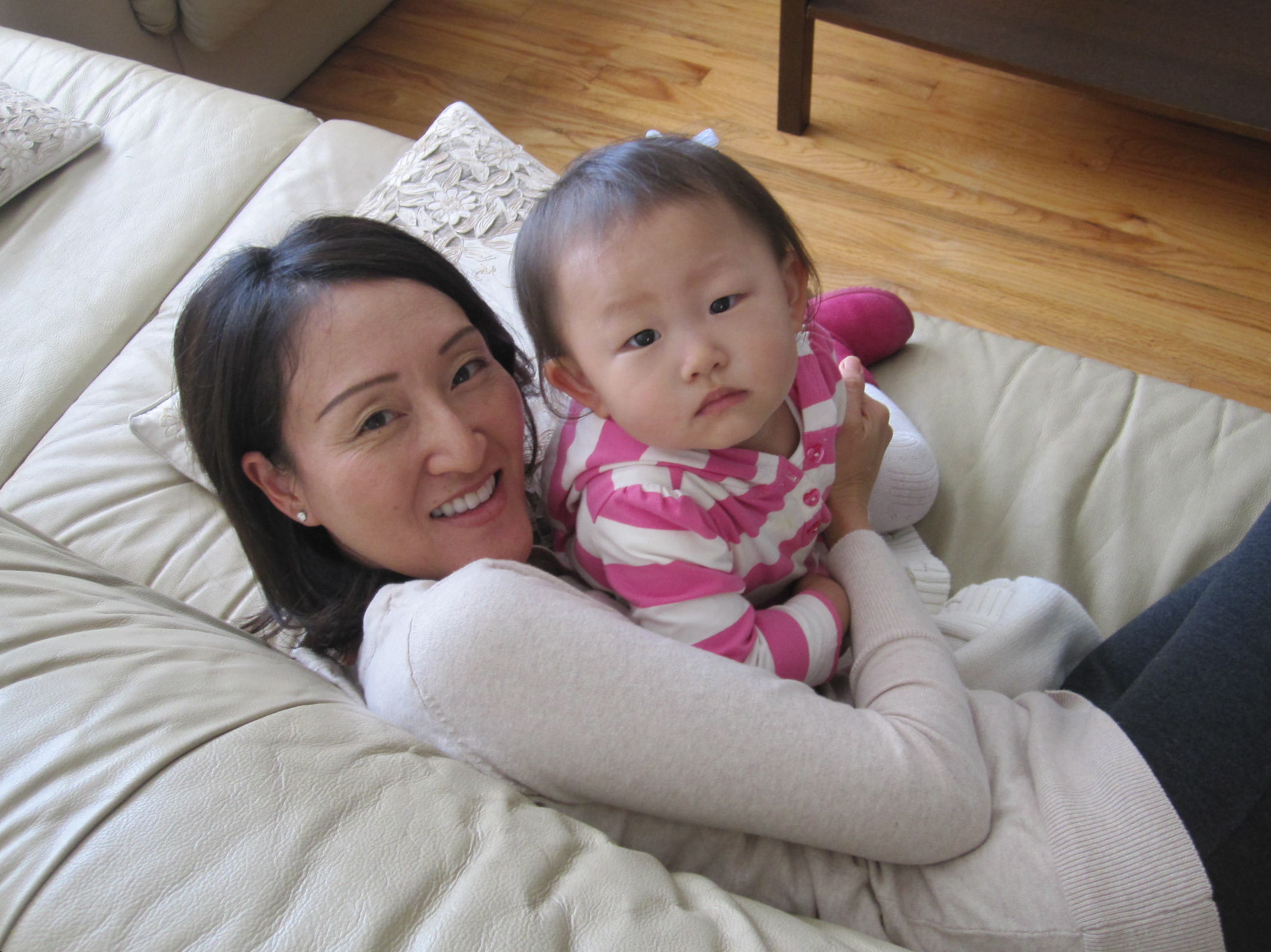
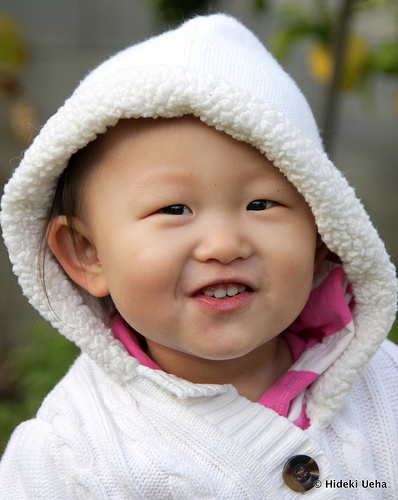 Bebe E, Oshogatsu 2011
Bebe E, Oshogatsu 2011
Photographed by Hideki
- About 16 - 20 cups of water
- 1 large 4 inch x 4 inch piece of drieddashi konbu
- Roughly ½ cup sliced carrots
- Roughly ¾ cup sliced (and halved) daikon
- Handful of mizuna (leaves and stems)
- Roughly 2 -3 tablespoons dried konbu dashi powder (or katsuo dashi for non-vegetarian option)
- 6 to 7 shakes of salt (Forget teaspoons! My Mom actually counted the number of times she shook the salt shaker for me - thanks Mom!)
- Roughly 2 to 3 tablespoons shoyu (almost a ladle-full according to Mom)
- Minimum 1 piece of mochi per person
- ½ block of kamaboko, sliced and then halved (optional; omit for vegetarian ozoni)
- Optional: 3 pieces of chicken breast tenderloin, chopped into bite-sized pieces.
- In a large stock pot, add the large piece of dashi konbu and water, then boil. Reduce heat to medium.
- Add dried konbu dashi (or katsuo dashi) powder and soy sauce. Simmer for a few minutes. If you are going to add chicken to the ozoni, add the chicken at this point, cook on low (to keep it tender) and skim off residue.
- Add carrots and daikon. Cook until tender. Reduce heat to low. Add salt.
- Just before the ozoni is ready to be served, add a handful of the mizuno, simmer for a few minutes until tender.
- Our mochi was frozen, so we warmed them up in the microwave with just a little water on the plate for about 15 - 2o seconds until soft. Add the mochi to the stock pot and allow it to continue to cook for about a minute.
- Place two pieces of kamaboko inside each individual serving bowl. Add 1 mochi plus soup and serve immediately.


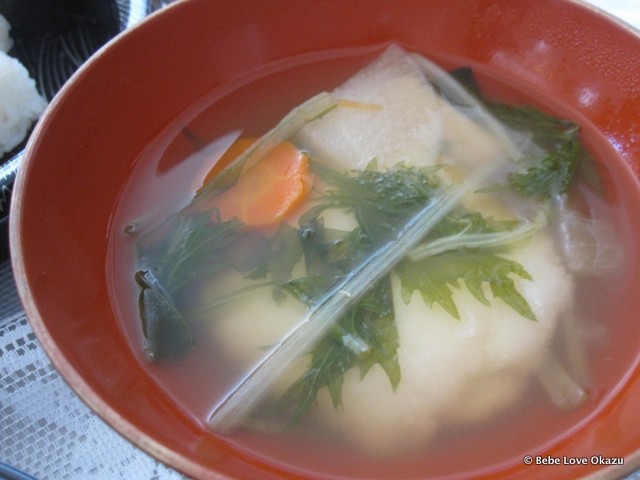
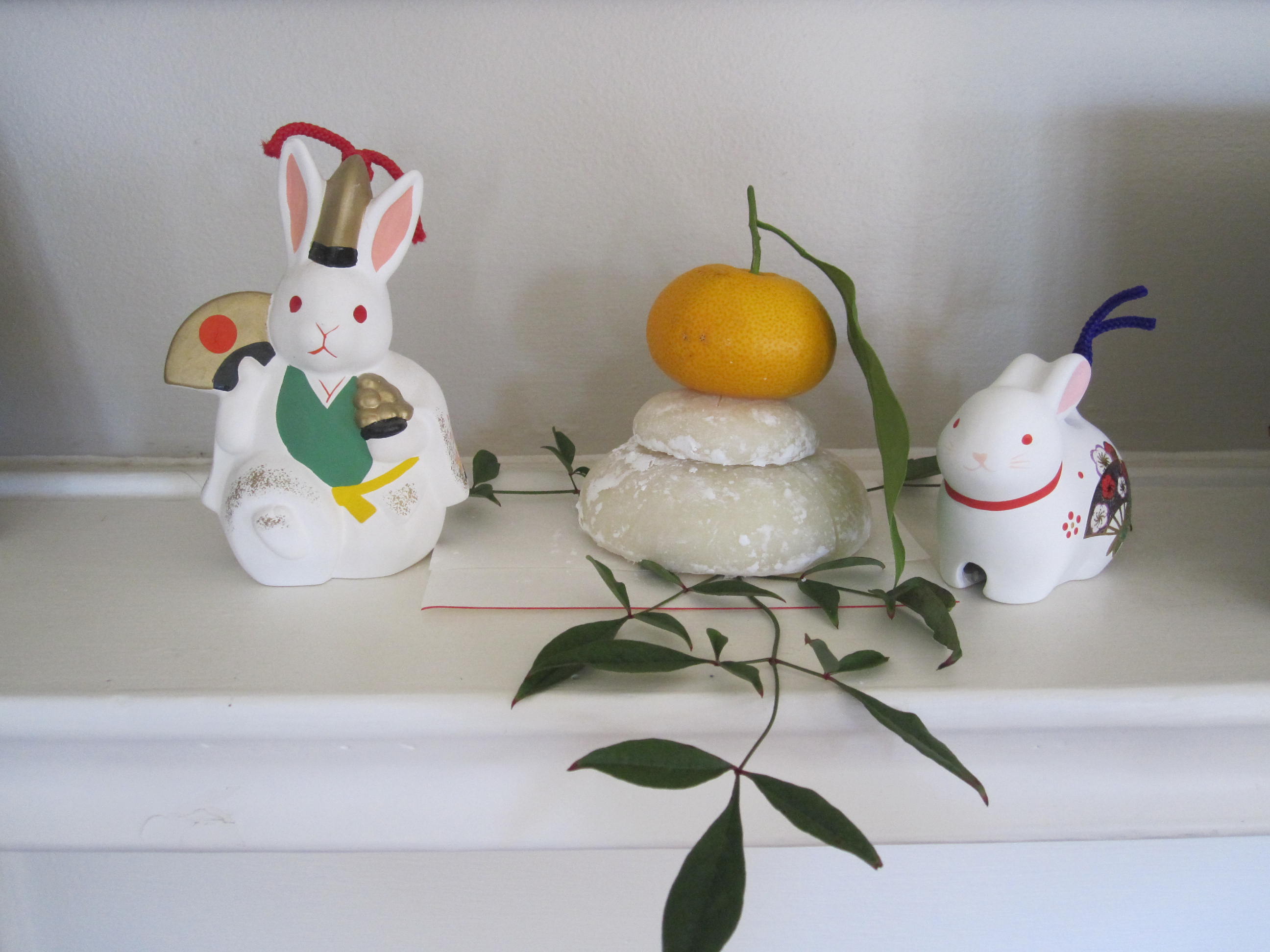
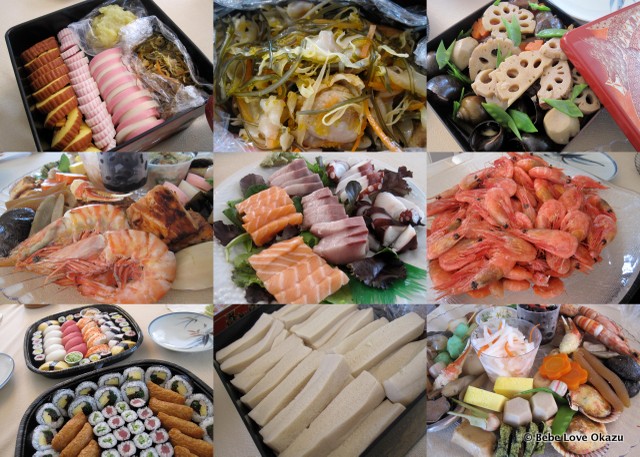

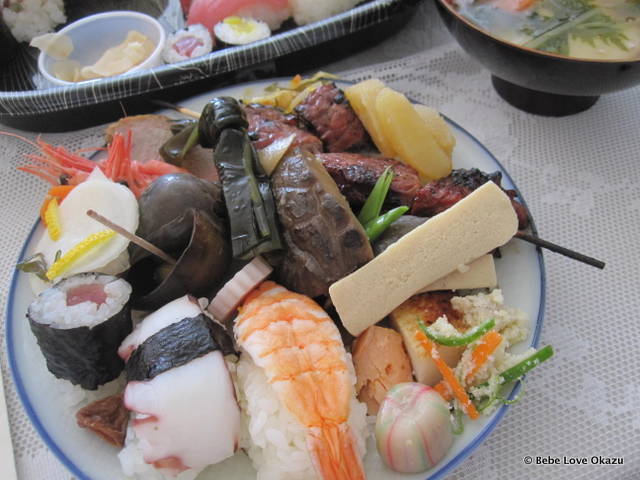

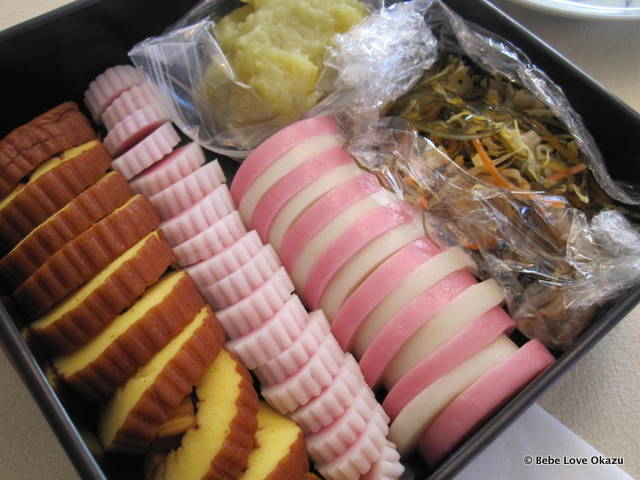
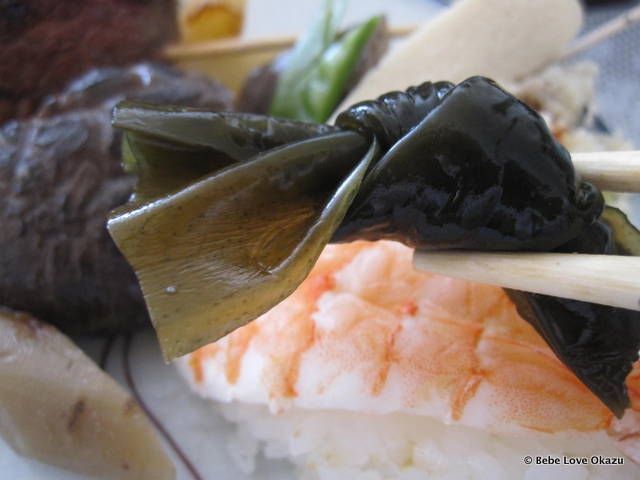
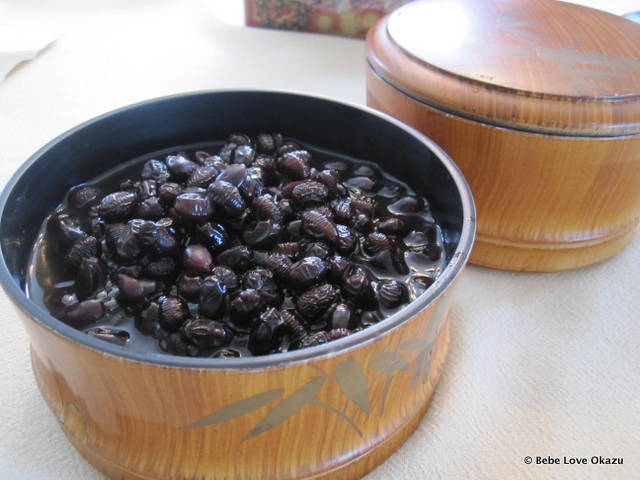
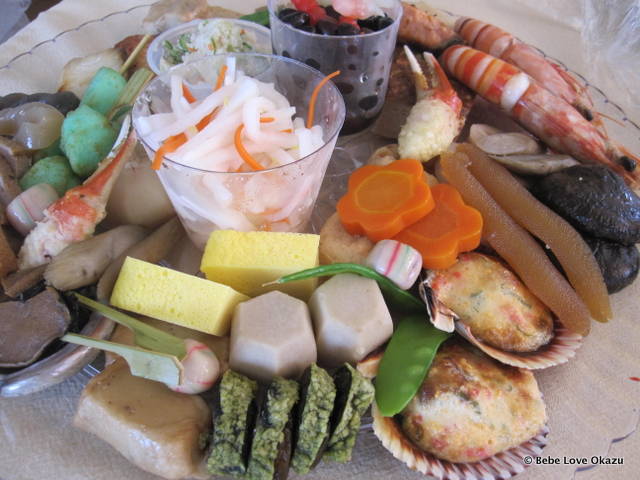

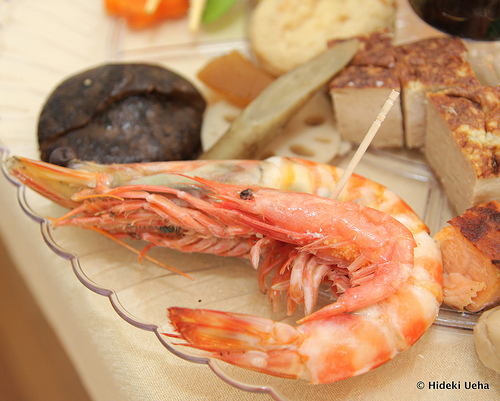




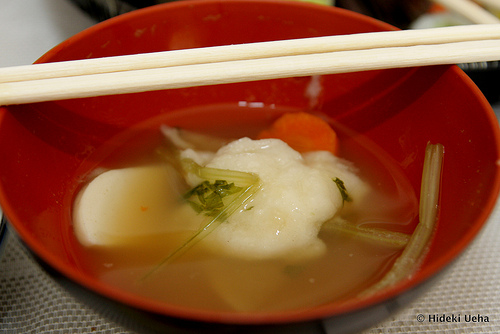
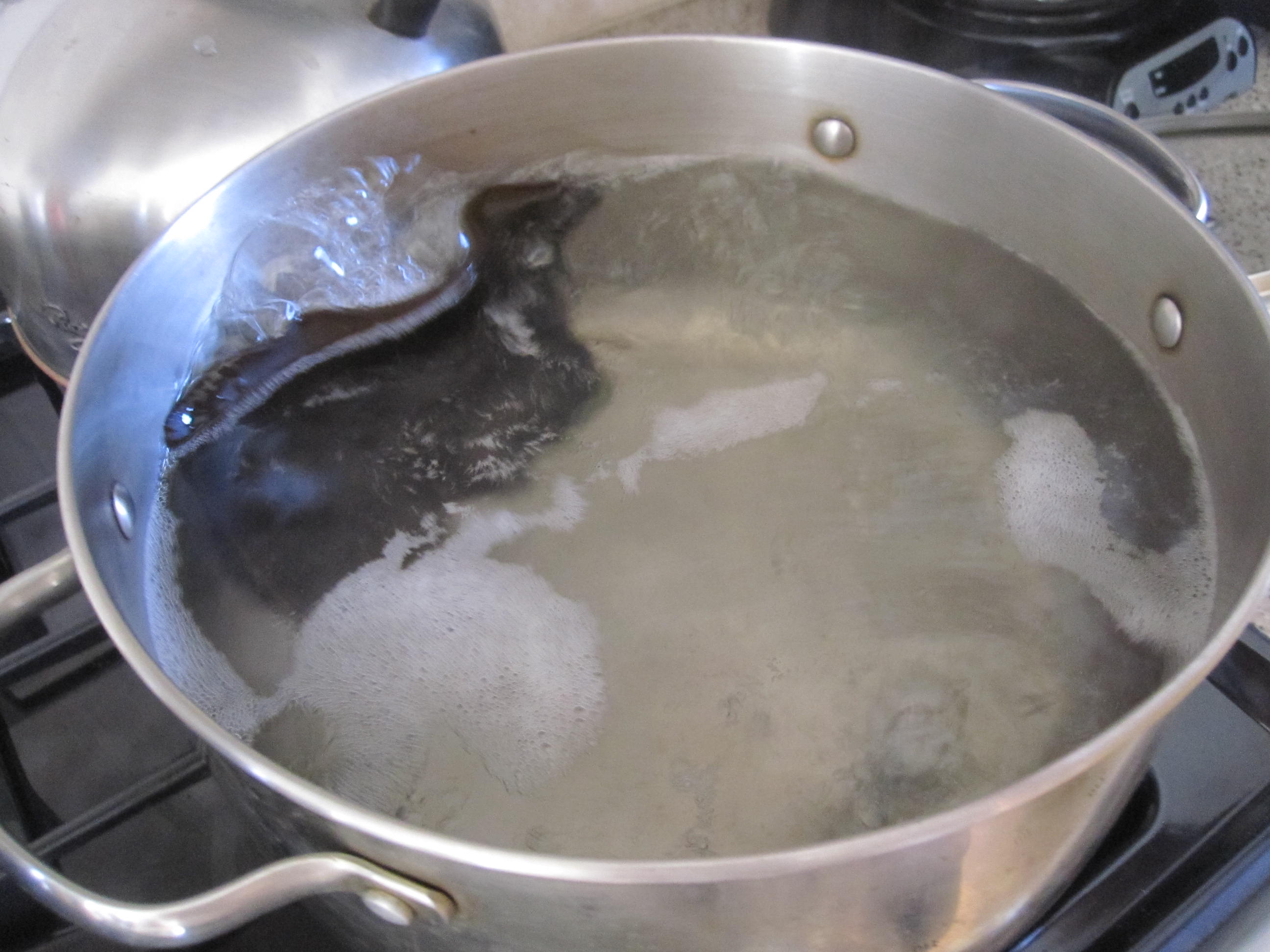
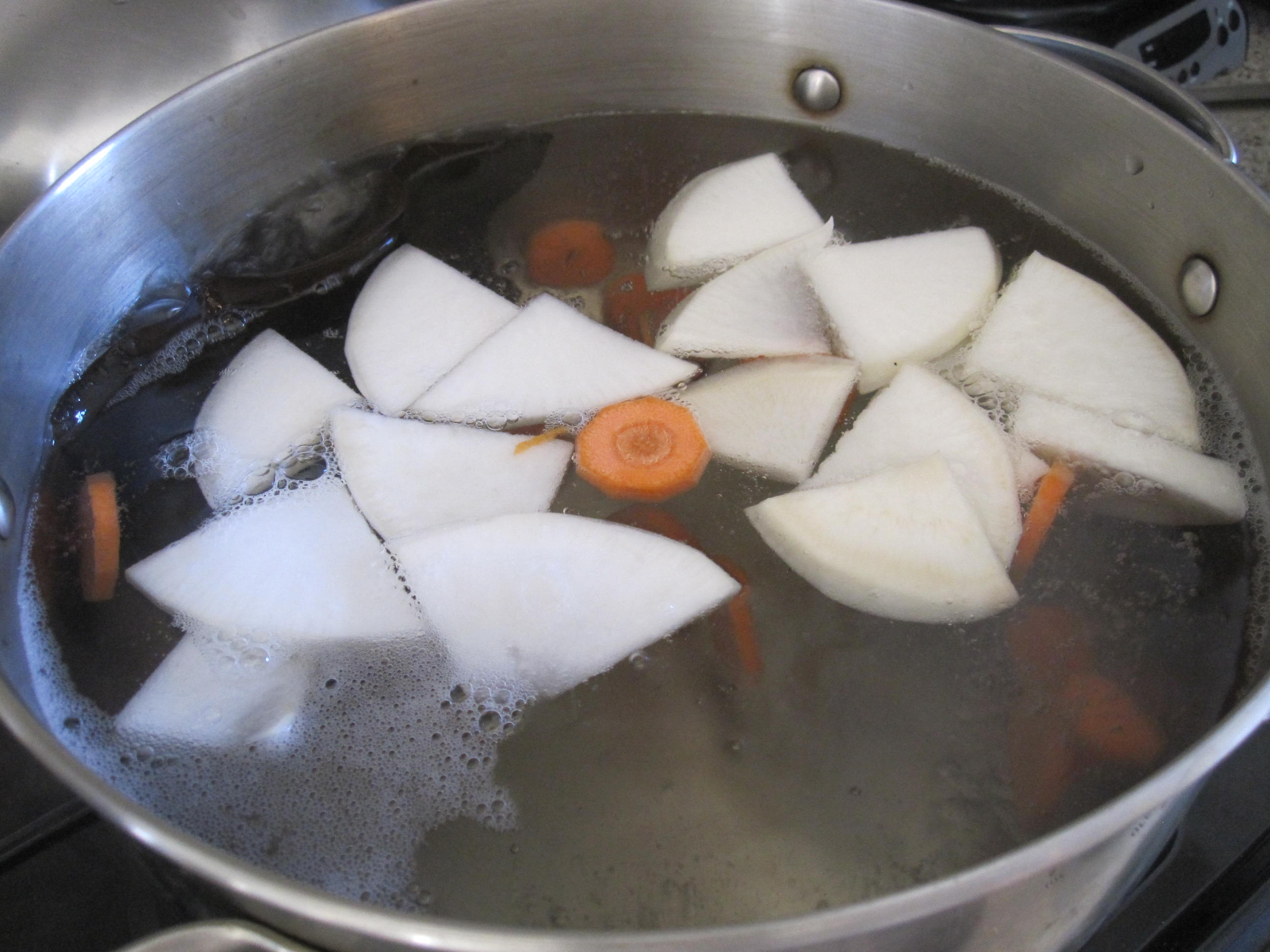
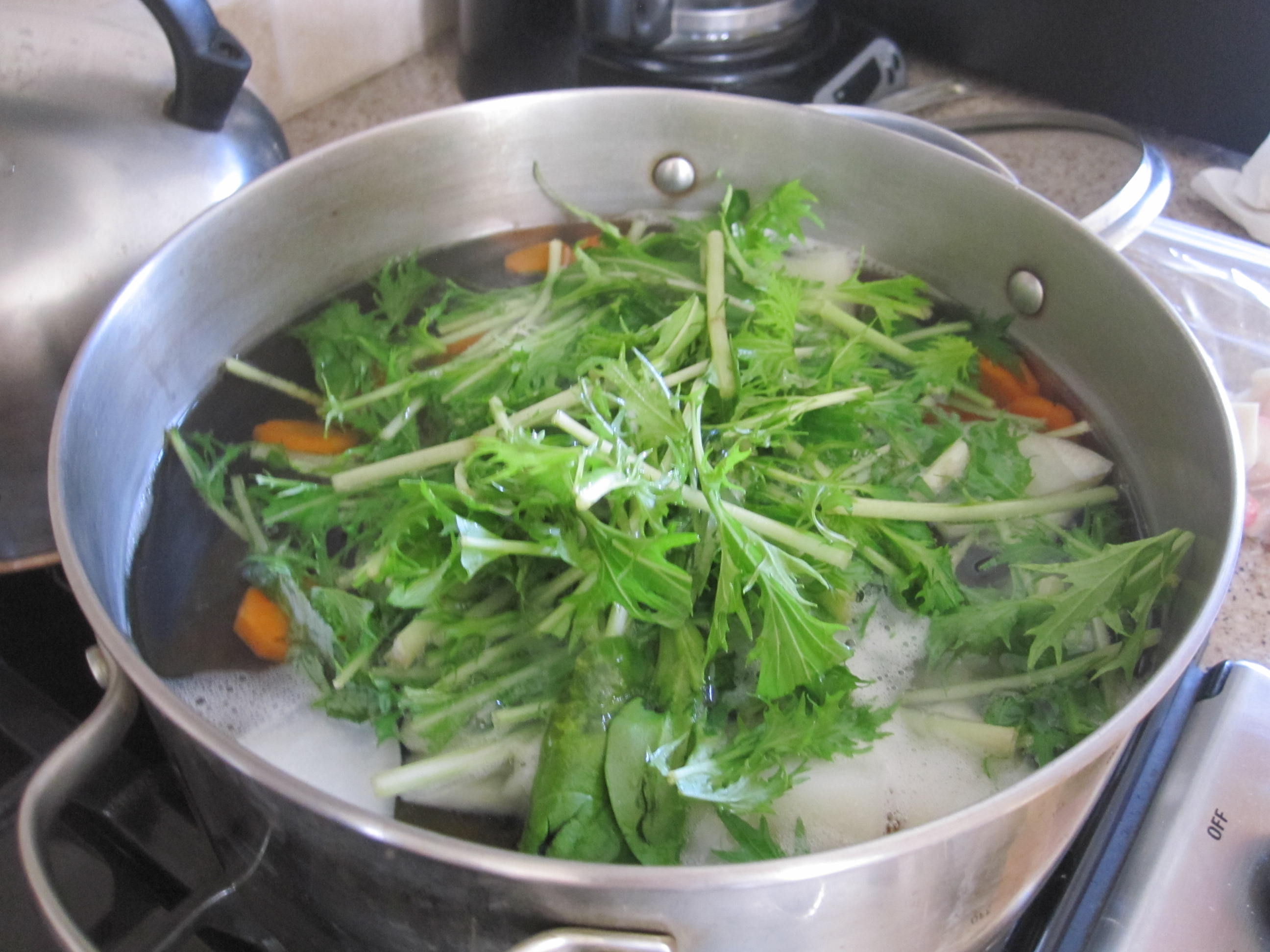
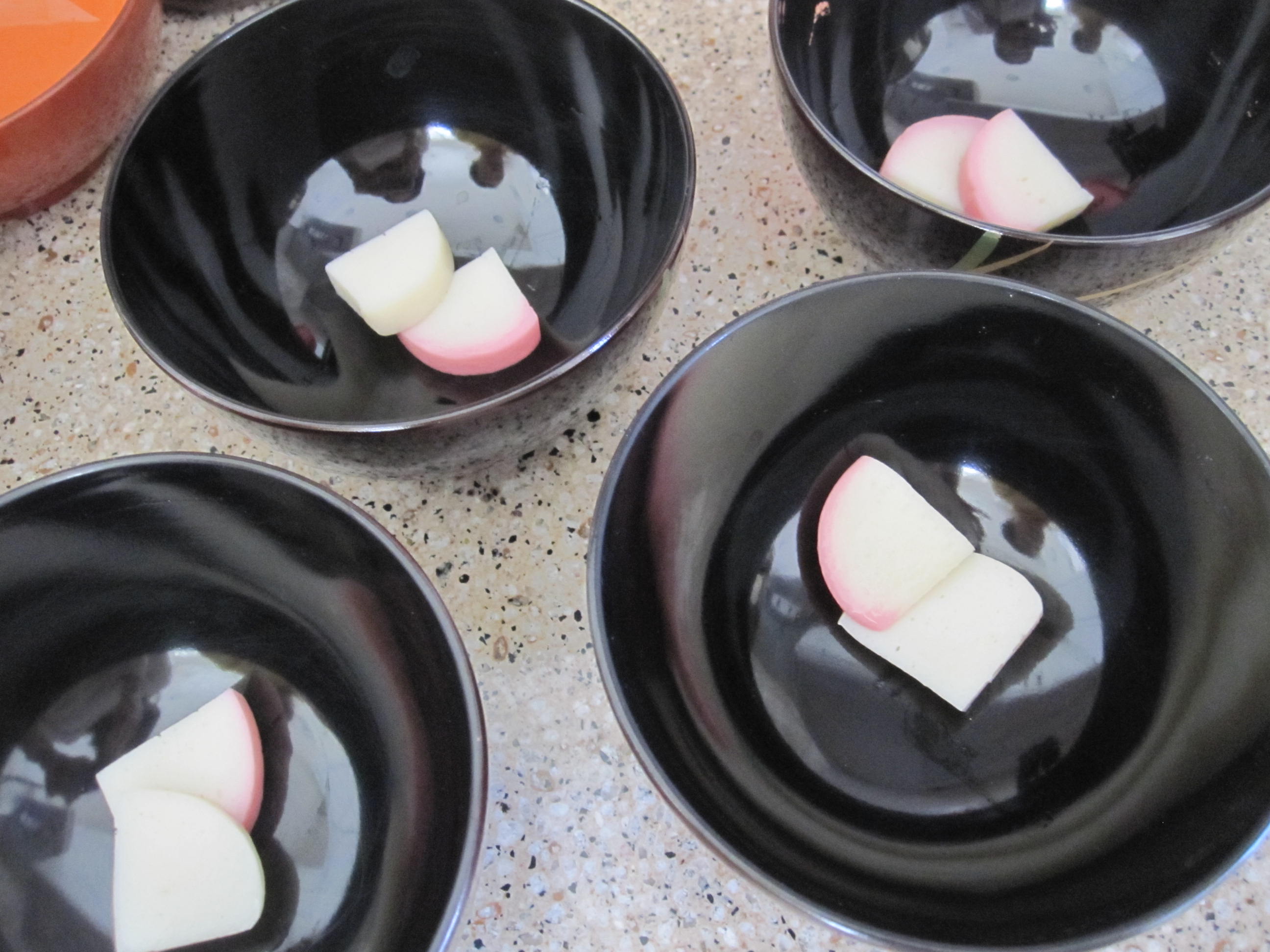
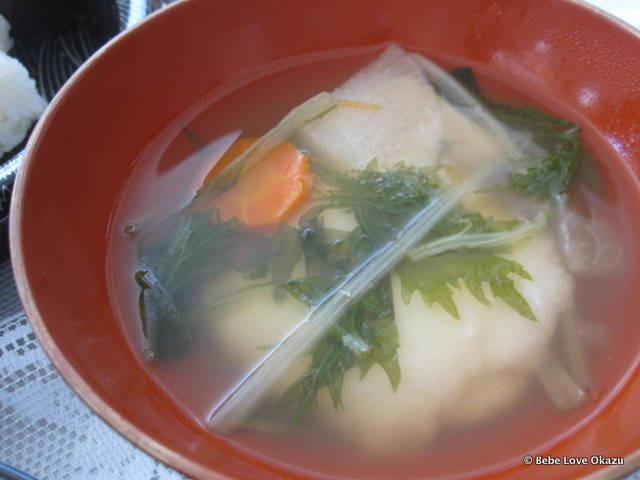
23 Comments